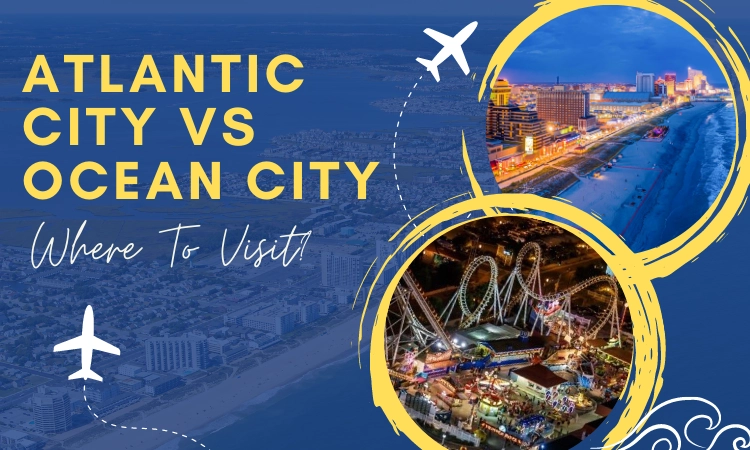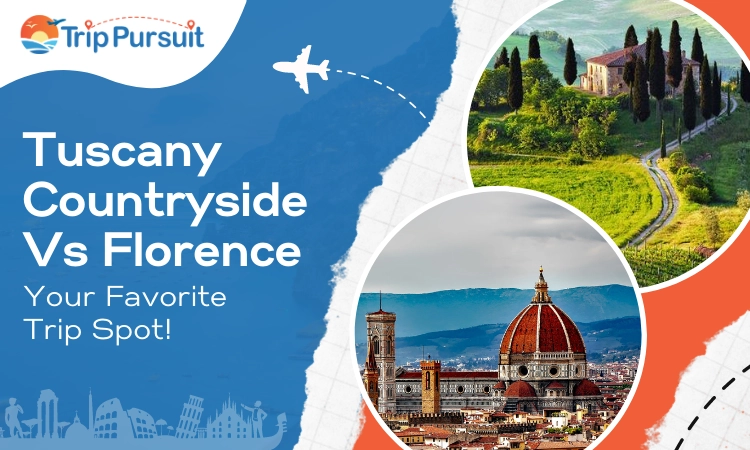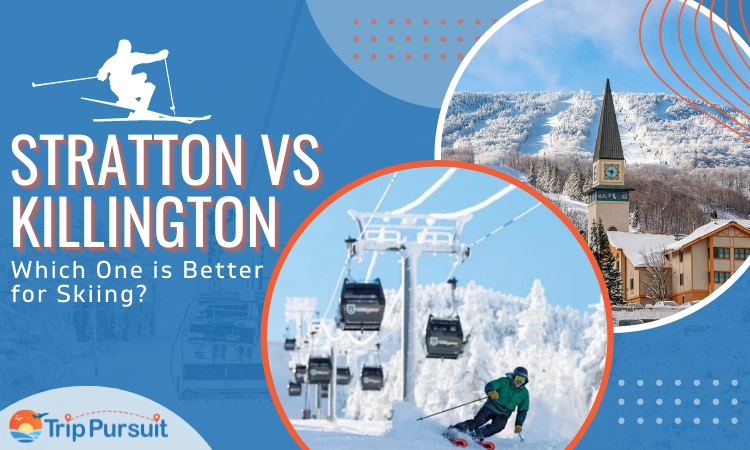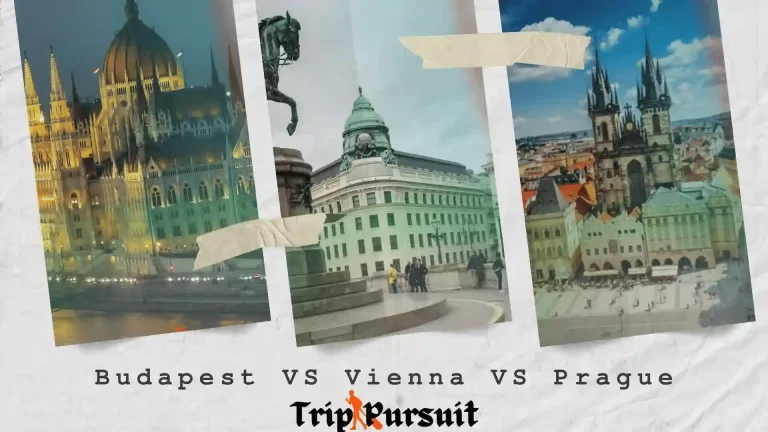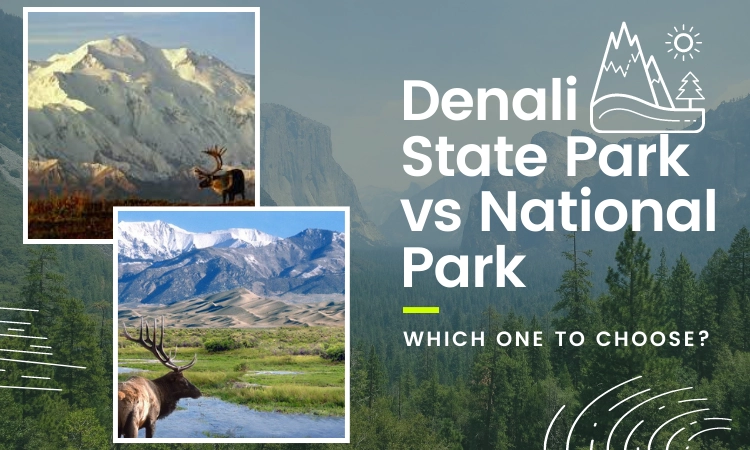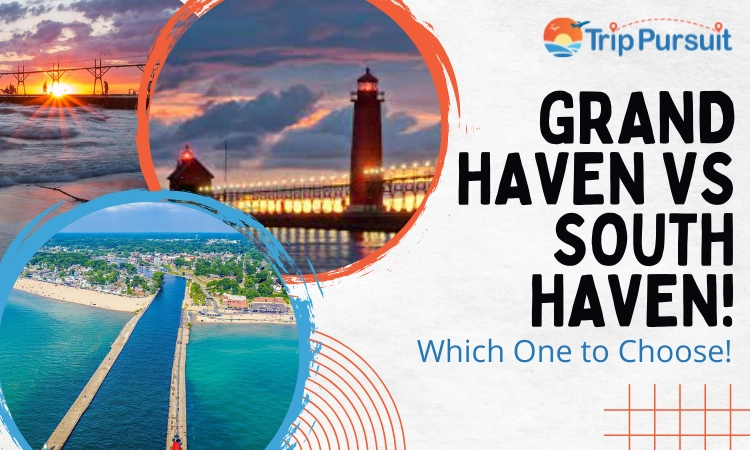A Tourist’s Guide to Tuscany: 7 Days Itinerary in Tuscany, Italy
Welcome to Trip Pursuit, where we explore the world one destination at a time. Today, we have the pleasure of interviewing Valerio Simoncini, a wildlife biologist, and international naturalistic tour guide based in Tuscany.
Valerio has shared with us some of the best places to visit, eat, and stay during your trip to this beautiful region of Italy. So, if you’re ready to plan your dream vacation, grab a pen and paper and let’s get started!
Also, if you want to hear straight from our guide Valerio Simonchini, then here’s the whole podcast –
When Is the Best Time To Visit Tuscany?
Planning a visit to Tuscany requires proper timing and an understanding of the region’s diversity. According to Valerio, the best months to visit Tuscany are from March to May and from September to October. February is usually the coldest month in Italy and Tuscany, while November and December experience heavy rainfall.
Visiting in spring and early fall is ideal because the temperatures are moderate, making it perfect to explore the region. In summer, the temperatures can be hot, and it might be difficult to travel around Tuscany as a tourist.
When planning a visit to Tuscany, it is essential to note that the region is vast and diverse. Florence is just one of the cities in Tuscany, and it is not the only place to visit.
Tuscany Itinerary: How To Spend 7 Days In Tuscany?
Before starting on the itinerary, Valerio told us about one common mistake most tourists do which is to make the mistake of assuming that Tuscany is a place or a city as Firenze. Firenze is considered the main city (‘’Capital’’) of the region called Tuscany. He wants the tourists to explore the whole region to discover the different tastes of wine, as for any local food and landscape that are a significant part of Tuscany’s culture and heritage.
Every valley in Tuscany has a different taste of wine, depending on the grapes’ growth, soil conditions, exposure to the sun and wind, humidity, etc. and depending on the way how grapes are transformed into wine.
As Tuscany is known for some of the best olive oils worldwide, we asked Valerio about Olive Oil Tour and he also recommends exploring the production of extra virgin olive oil.
The olive trees grow on the hills of Tuscany and are exposed to the sun and wind, making them ideal for producing high-quality olive oil. Tuscany produces some of the best extra virgin olive oils globally, and tourists can visit the various olive farms in the region to learn about the production process.
Bonus: How to get to Burano from Venice – Land or sea route?
Now, here is a 7 Days Itinerary in Tuscany, Italy suggested by Valerio on our Youtube, Itinerary Podcast:
Day 1 & 2 – Florence
According to Valerio, you must start your tour of Tuscany from Florence and stay there for 2 days to properly explore the city. Visit the iconic Florence Cathedral, also known as the Duomo, which is one of the most iconic landmarks of Florence. Visitors can climb to the top of the dome for a stunning panoramic view of the city.
You can visit the Uffizi Gallery, which is one of the most famous art museums in the world. He mentioned that the museum houses a vast collection of Renaissance art, including works by Michelangelo, Botticelli, and Raphael.
You can see the Doni Tondo, also known as the “Holy Family”; Tondo Pitti, known as the “Battle of the Centaurs”; Bacchus; etc. by Michelangelo; Botticelli’s the Birth of Venus, Primavera, or Raphael’s Madonna of the Goldfinch among other works.
Then, visit the Ponte Vecchio, which is a historic bridge that spans the Arno River. Valerio describes it as a popular spot for tourists to take photos and stroll around. Characteristic is also to spend some hours of the evening there, up on the Ponte Vecchio where several different artists and musician plays for free
Explore the Oltrarno neighborhood, which he said has a more authentic and less touristy feel. However, the area is especially known for its artisan workshops, and visitors can find unique handmade goods such as leather bags and jewellery.
For those interested in natural attractions, Valerio lists the hills and mountains around Florence. Visitors can take a public bus to Fiesole, a small town just over the city of Florence, to get a view of the valley of the Arno River around the city of Firenze.
Fiesole is located on a hill and offers a breathtaking view of the Tuscan countryside. Another spot to visit is Piazza Michelangelo, in the same city of Firenze, just about one hundred steps over the river, which offers a view of the city and the valley.
From here Visitors can climb some more steps to reach the most ancient church in Florence, San Miniato Al Monte, which is over 1,000 years old. This spot is particularly popular at sunset, as visitors can watch the sun go down over the city.
Try the local cuisine in Florence, specifically the famous Florentine steak. There are several restaurants in the city that serve this dish.
What to Eat: For lunch, Trip Pursuit recommends you to try some traditional Tuscan dishes such as Ribollita soup or Bistecca Alla Fiorentina, a juicy grilled T-bone steak. For dinner, try out the pizza at Gustapizza, a local favorite with a long line out the door.
Where to Stay: You can stay at a luxurious hotel near the Byzantine tower in the center of Florence or at affordable modern hotels.
Transportation: Use a taxi or walk to get around the city. The tourist spots are within walking distance, or you can also use public transportation. ( A.t.a.f. buses).
Cost: You will require an estimated $200-$250 (at least) per day for your stay in Florence based on your activities, meals, and accommodation.
Day 3: Pisa and Livorno
Take a day trip to the historic towns of Pisa and Lucca, located about an hour west of Florence. Pisa is known for the iconic Leaning Tower, which is part of the Piazza dei Miracoli complex.
Valerio told us to take a local or regional train from Florence to get to Pisa and Lucca. The regional train from the Santa Maria Novella train station in Florence will be a good option, as it is a direct route to both Pisa and Lucca.
In Pisa, Valerio spoke about the famous Leaning Tower of Pisa, which is a UNESCO World Heritage Site. When you’re there, also visit the Pisa Cathedral and Baptistery, which are located in the same piazza as the tower.
Livorno is 20 minutes drive away from Pisa, which isn’t as popular with tourists, but something Valerio has suggested we must visit. It’s a very beautiful city beside the coast of the sea of Tuscany. You can see the Historical Center of Livorno and its channels known as La Venezia (the Venice). It’s similar to Venice and all the channels come from the sea.
You can head to Maremma next, which is a part of the Province of Grosseto. It is in the coastal region of southwestern Tuscany. Maremma is known for its natural beauty and Valerio described it as very peaceful. It is a really wild place and you can visit the Natural Regional Park there.
If you have more time, our recommendation is to check out Lucca as well. Lucca is 35 km away from Pisa, which you can also add to your itinerary. You can rent a bike to explore the city’s medieval walls and historic center.
Do check out the Piazza dell’Anfiteatro, which is a unique oval-shaped square that was once a Roman amphitheater, and the Cathedral of San Martino, a beautiful example of Pisan Romanesque architecture.
Lucca is known for its local cuisine, including dishes like Buccellato (a sweet bread) and Tortelli Lucchesi (a type of pasta filled with meat or cheese). Spend the night in Lucca or head back to Florence.
What to eat: We’ll say try the local specialties such as the Buccellato, a traditional sweet bread from Lucca, for dinner. Buccellato is a ring-shaped bread that is filled with raisins, anise seeds, and sometimes other dried fruits or nuts. It is a delicious and sweet treat that is perfect for dessert or breakfast.
Where to Stay: You can stay at an Airbnb which can be 70-80 euros one night.
Transportation: Take a local train from Florence to Pisa and Lucca. Valerio did caution us on the train – it will be slow and stop at many towns and villages before you finally reach Pisa. You can drive to Livorno if you have rented a car.
Cost: Train from Florence to Pisa: €10-15 per person (one way), Admission to Piazza dei Miracoli complex in Pisa: €18 per person, Bike rental in Lucca: €10-15 per person, Dinner in Lucca: €20-30 per person, Accommodation in Lucca or Florence: €80-150 per night.
Day 4 – Florence to Chianti
According to Valerio, the best way to reach Chianti from Florence is by renting a car. While in Chianti, one can visit vineyards and wineries, taste local wines, and enjoy the beautiful countryside views. Start your day by visiting the town of Greve in Chianti, known for its weekly market and beautiful piazza.
In reply to what to see in Chianti, Valerio has told us to visit the heart of Chianti, which is the valley of the Greve River. In this area, visitors can find the Castello di Verrazzano, a castle located on top of a hill. The castle has been preserved in its original form from seven to eight hundred years ago and is a beautiful sight to see.
Visitors can also taste different kinds of wine at the castle, especially the San GIOVESE wine, which is made from the ancient grapes grown by the Etruscan people. The Etruscan people were the native people of Tuscany who started to grow and produce wine through the San GIOVESE grape before the Roman Empire.
In Chianti, visitors can taste the real San GIOVESE wine, which is also the main grape to produce a “Chianti” wine, as Valerio explained to us, following the rules and laws of the ‘’disciplinare’. Visit a local winery for a tour and tasting of Chianti wine.
From our research, we’d also suggest you to explore the medieval hilltop town of Panzano, known for its panoramic views and charming streets.
What to Eat: For lunch, Trip Pursuit recommends you to enjoy a traditional Tuscan meal at Osteria Le Cantine, a family-run restaurant in Greve.
Where to Stay: Stay at Borgo San Felice, a luxurious hotel in the heart of Chianti, surrounded by vineyards and olive groves. Or, you can find an Airbnb at a cheaper rate.
Transportation: Rent a car or use a private driver to get to Chianti.
Cost: Expect to spend around $300-$350 per day.
Day 5: Chianti Wine Region
Since you are in Chianti, there are several places and things to see in the Chianti region, including the picturesque countryside, vineyards and wineries, small towns and villages such as Greve, Panzano, and Radda, as well as historical landmarks like castles and churches.
Valerio told us about the Badia a Passignano Abbey, which dates back to the 11th century and has a beautiful Romanesque church and a wine cellar. Here, visitors can taste the famous Chianti Classico wine.
What to eat: As Valerio previously suggested, always ask the locals which food you must try. Taste some of the famous Chianti Classico wines, and try some of the local cheeses and cured meat. You can also enjoy a traditional Tuscan meal with some of the local wines for dinner.
Where to Stay: Spend the night in a charming agriturismo or a bed and breakfast in the heart of the Chianti region.
Transportation: Explore the Chianti region by car. He advised taking the SS222 road which is also known as the Chiantigiana road. The road goes through the heart of the Chianti region and offers breathtaking views of the countryside.
Cost: Expect to spend around 120-150 (maybe more) euros per person for transportation, food, and wine tastings.
Day 6: Siena and San Gimignano
Chianti is in the middle of Firenze and Siena, so when you’re in Chianti, you must visit the countryside. Valerio provided some insights into the places to visit in Siena and San Gimignano (which is not too far from the City of Siena).
According to him, in Siena, you can visit the Piazza del Campo, which is a popular square where the Palio di Siena horse race takes place twice every year.
The square is surrounded by historic buildings, including the Palazzo Pubblico, a beautiful palace that houses the Civic Museum.
You can also visit the Siena Cathedral, which is a stunning medieval cathedral with a white and green striped facade. The interior of the cathedral is equally impressive, with intricately carved sculptures and colorful frescoes. The Piccolomini Library, located inside the cathedral, is also worth visiting.
In San Gimignano, you can see the Piazza della Cisterna, which is a beautiful square surrounded by historic buildings. The Torre Grossa, a towering medieval tower, is also located in the square and offers stunning views of the surrounding countryside.
Valerio also suggested visiting the Collegiate Church of Santa Maria Assunta, which is a beautiful church with a Romanesque facade and Gothic interior.
The church houses some impressive works of art, including frescoes by Benozzo Gozzoli ( a Painter and Artist native of Castelfiorentino – same native town of our Guide Valerio Simoncini, as he explained to us- who was committed to painting ‘Affreschi’ all around the valley of the Elsa River, that run from the south of Siena to the Arno river, south of Empoli city, and takes place in the province of Siena but also in one of Firenze.)
What to Eat: Try local specialties such as pici pasta with meat sauce or wild boar stew for dinner
Where to Stay: Trip Pursuit will suggest you to spend the night in San Gimignano. You can consider staying at hotels located within the medieval walls of the town or in a historic building.
Transportation: Take a train from Florence to Siena and then rent a car or take a bus to San Gimignano. We asked him for the easiest way to explore both cities, and he suggested driving around is the best way to explore.
Cost: Expect to spend around 120-150 euros per person for transportation, food, and attractions.
Day 7: Tuscan Countryside
On the 7th day in Tuscany, Valerio told us to head north to the Appennini, a big mountain complex in Italy to experience something different. This region is located above Florence, Pistoia, Prato, and Lucca and offers a different perspective of Tuscany with real mountains.
Alternatively, if you prefer fancy places and sandy beaches, you can head to Versilia, the north coast of Tuscany, at the border with Liguria, very close to the Cinque Terre National Park. You can still be in Tuscany, but the landscape is completely different in Versilia.

Another option is to visit Forte dei Marmi, which is very close to the caves of Carrara marble, known for its white, expensive marble. The Carrara marble comes from the mines and caves at the feet of the APUAN Alps ( Alpi Apuane) that is next to the region where the Alps and the Appennini meet.
At the feet of those mountains, there is the sea and the cities of Carrara and Massa and also Viareggio, which is the capital of Versilia. In February, Viareggio hosts the Carnival which you can also enjoy if you visit during that time.
In the afternoon, drive back to Florence or your next destination, and return your rental car if you have one.
Other Options: You can go to the areas of VALDORCIA & BRUNELLO DI MONTALCINO, South of SIENA (between Siena and Grosseto).
What to Eat: Taste some of the local specialties such as pecorino cheese and wild boar salami in Montalcino, and have lunch at the Taverna dei Barbi, a traditional restaurant located in the nearby town of Montenero d’Orcia. Try local dishes such as homemade pasta with truffle sauce, roasted pork, and tiramisu for lunch.
Where to Stay: Drive back to Florence or your next destination, and return your rental car if you have one
Transportation: You can rent a car or take a Vespa tour with a local guide if you are traveling solo. You can also take a Fiat 500 for a tour in the hills.
Cost: Expect to spend around 100-150 euros (maybe more if it’s the vintage one!) per person for transportation, food, and wine tastings. A tiny Fiat will cost you around 40-50 euros per day.
Where to Go for Tuscany Wine Tasting?
There are several vineyards, including Castello di Ama, Castello di Brolio, Villa Le Piazzole, Castellinuzza e Piuca, and Tenuta di Capezzana to go for Tuscany wine tasting, according to Valerio. Each of these vineyards offers a unique experience for visitors, from exploring the vineyards and cellars to tasting different wines.
One thing Valerio advised tourists is that most vineyards in Tuscany require advance reservations. So, you need to plan ahead to ensure they have a spot.
We asked him the best time to visit Tuscany for wine tours to which he replied during the fall when the grapes are harvested. There are many events and festivals celebrating wine which you can participate.
Visitors to Tuscany can also consider taking a wine tour through a tour operator. For this, you can contact several reputable tour companies, including Tours of Tuscany and Tuscany Untouched Tours, and “Arno Travel”
Is Tuscany Good for Solo Travel?
Yes, Tuscany is generally a safe place for solo travelers, including female travelers. Valerio mentions that he has grown up in Tuscany and spent lots of years around the world living and working in 4 continents and he can assume that aren’t big problems in his native region, especially as a tourist, for example, in respect some other touristic areas of the world.
He also notes that there is not much crime in the region and that the people are generally friendly and helpful.
Valerio specifically mentions that there are many solo travelers, including female travelers, who come to Tuscany and have a great time. He suggests that solo travelers can stay in a hostel or an Airbnb and can easily meet other travelers in cafes, bars, or restaurants.
He also notes that there are many cultural events, such as concerts and festivals, where solo travelers can meet locals and other travelers.
Tuscany is safe for solo female travelers, however, Valerio does caution that they should take the usual precautions when traveling alone. For example, being aware of their surroundings and not walking alone in dark or deserted areas at night. He also advises solo travelers to be mindful of pickpockets and to keep their valuables safe (especially in the train stations).
Is English spoken in Tuscany?
Yes, English is spoken in Tuscany. When it comes to language, Valerio assures visitors that many people in Tuscany speak English. He notes that while Italian is the primary language, locals in the tourism industry are typically fluent in English and other languages.
If you have a love for beaches and you are in Italy then do consider visiting Praiano or Positano.
Where to Shop In Florence?
For those interested in shopping, Valerio suggests visiting the historic town of Arezzo, known for its beautiful antique markets and artisanal shops. He also recommends exploring the medieval town of San Gimignano, which boasts a variety of artisanal shops selling everything from leather goods to ceramics.
Does Florence Have Good Nightlife?
Yes, Florence has good nightlife. In Florence, the popular areas for nightlife are Santa Croce and Santo Spirito, where there are several bars and pubs to enjoy a drink with friends.
The city is famous for its historic and elegant cocktail bars such as Negroni and Harry’s Bar, which provide a more sophisticated atmosphere for a night out.
For those who prefer clubs and dancing, there is a Space Club in Florence, which plays electronic music and has an outdoor terrace with views of the city. Another popular spot is the Tenax Club, which hosts international DJs and live concerts.
Outside of Florence, you can visit the town of Viareggio, located on the coast. The town has a vibrant nightlife scene with a variety of bars, clubs, and restaurants. In summer, the beach clubs along the coast also offer entertainment and music events, making it a great destination for a night out.
Expert Take on Transport, Accommodation, and Budget
Valerio has provided us an estimation of the costs and transportation for a 7-day itinerary in Tuscany in the podcast. Here is an easy breakdown for your easy understanding-
Accommodation
The cost of accommodation may vary depending on the location and the amenities provided. The Airbnbs in Florence can cost around 70-80 euros per night for a double room for two people.
Transportation
- Trains: You can use trains, including Frecciarossa, the fastest train in Italy, to travel between big cities like Rome, Florence, Bologna, Milan, Turin, and Venice. Local trains are also available to visit smaller towns and villages, but they may take longer. Prices for Frecciarossa trains are 2-4 times more expensive than local trains.
- Local trains: Firenze-Pisa can cost less than 15 euros, maybe 10 euros, depending on the booking time.
- Car rental: Rent a car to experience the real Tuscany, especially if visitors want to explore the countryside and visit family factories. Renting a car can be expensive, including insurance, bureaucratic stuff, and papers. Renting a Vespa also requires an international driving license.
- Private Van: You can rent a private van with a driver, known as NCC. It’s more expensive than renting a car, but visitors don’t have to worry about driving.
The exact figures for the costs of renting a car or NCC are not provided, as they may vary depending on the rental company, the type of car, the duration of the rental, and the location.
Budget
Overall, a 7-day itinerary in Tuscany can cost you around 2000-3000 euros (at least), depending on your preference, mode of transport, accommodation, and meals. Shopping and other expenses are not included.
Tips from the Expert in Visiting Tuscany
- For wine tasting, start early in the day to avoid the crowds.
- Visit the smaller wineries for a more personal and authentic experience.
- Book a wine tour in advance as some wineries require reservations.
- For dining, try the local dishes and ask the locals for recommendations.
- Be cautious while driving on the winding roads of Tuscany and take breaks when needed.
- Use public transportation to visit some of the popular tourist spots in Tuscany.
- Make sure to check the hours of operation for shops and restaurants as they may vary depending on the season.
Apart from these, there are many small tweaks that can help you make the most out of your trip. You can contact our guest Valerio Simoncini before going on a Tuscany tour.

Final Thoughts
This 7 days itinerary in Tuscany provides a great introduction to both Florence and the surrounding Tuscan countryside. From exploring art museums and historic landmarks to tasting local cuisine and wine, there’s something for everyone on this trip.
With the help of Valerio Simoncini’s recommendations, you can experience the best of Tuscany and make unforgettable memories along the way.

